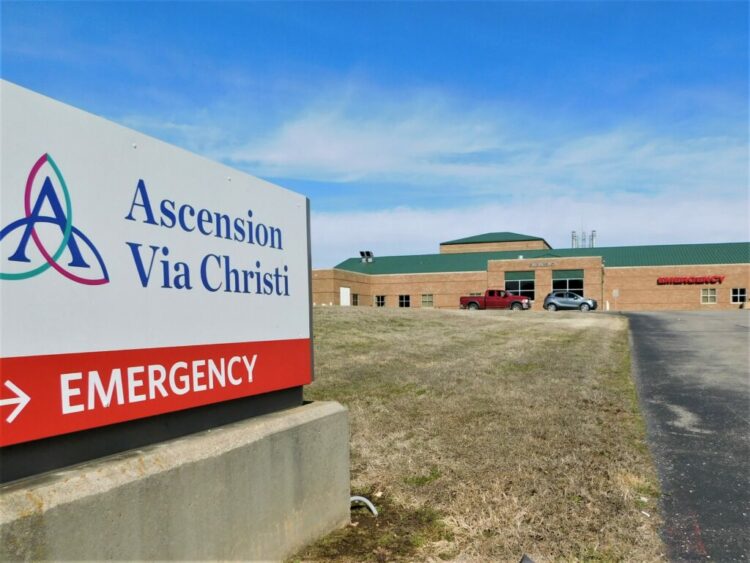The loss of the emergency department in Bourbon County on December 20 is on the minds of many in the community.
Ascension Via Christi Emergency Department cited “a steady decline in visits and its overall average daily census” in the press release announcing the closure.
Ascension Via Christi to close Emergency Department in Fort Scott on Dec. 20
Gregg Motley, Southeast Kansas Regional Manager of Landmark National Bank, proposed a question-and-answer interview on the current medical issues between him and Dr. Randy Nichols that would answer some of the questions the community has. Here is the interview.
Dr. Randy Nichols, who recently retired from a long medical practice in Bourbon County, answers some frequently asked questions from Bourbon County residents about the future of Emergency Room services in Bourbon County.
Motley:
Why do we need an emergency room? Would a great ambulance service with high-quality Emergency Medical Services personnel be just as good?
Nichols:
Emergency Medical Services (EMS) and Emergency Rooms (ER) are mutually beneficial services. EMS is to evaluate the on-scene emergency needs, provide the care available on the ambulance, and transport to the closest appropriate ER. Once EMS is involved, they are legally required to transport the patient to the closest appropriate ER. An ER, on the other hand, is available to both ambulance transfers and “walk-ins” seeking emergency care. An ER has lab and x-ray diagnostic capabilities. It has treatment options not available on an ambulance. Following diagnostic evaluation, a patient can be treated and dismissed or stabilized and transferred for hospitalization to a facility offering the needed services.
Let’s look at our utilization numbers to understand why EMS alone is not adequate. Approximately 2/3 of our ER visits do not arrive by ambulance. Of our total ER visits, less than ¼ ultimately require hospitalization. If most of the people seeking emergency care can no longer bring themselves to a local facility, the number of ambulance calls, and therefore number of transports out of the county, could triple. To staff this would be a prohibitive expense. More importantly, emergencies aren’t scheduled, so if multiple health events occur at the same time without a local ER, our ambulance system could be overwhelmed: people will be waiting longer and some will not get the care they need in a timely manner. Additionally, some people may choose to “ride it out” at home rather than call an ambulance or make a long drive to the closest ER. Both of these decisions put people at increased risk.
A brick-and-mortar ER is foundational to the safety and well-being of our community.
Motley:
Could a stop at an ER without an attached hospital jeopardize the life of a critically ill patient by delaying a life-saving treatment?
Nichols:
EMS is obligated to take a patient to the closest ER providing the needed level of care. However, that care may be identified as a need to stabilize in the local ER while arranging transport to a higher level of care. This is often a more controlled situation, improves patient safety, and, if for example Life Flight needs to be called, may shorten the time to distant hospitals.
Motley:
Why is government being asked to subsidize a private corporation? Do other rural communities fund / subsidize their ERs.
Nichols:
Healthcare reimbursement is unlike other business models. In order to get paid, a healthcare organization must meet a rigid group of CMS (Center for Medicare and Medicaid) standards. Reimbursement is based on “customary and reasonable” and/or negotiated fees. Reimbursement doesn’t equal charges and in many cases, episodes of care are never paid. To have an ER, a subsidy is needed whether it is private or “not for profit.” Of course, the subsidy needs to be based on real and regularly verified numbers.
Many other communities subsidize their health care. In our area, Iola, Garnett, and Parsons all subsidize. Nevada has a ½ cent sales tax to support their hospital. Ottawa, Kansas subsidizes about $2 million yearly to cover the cost of indigent care. In Kansas, more than 50 hospitals are at risk of closure. The Kansas Hospital Association reports many of these would already be closed if not supported by local subsidies.
Motley:
Are there subsidies for rural health care out there to lighten our local burden? Is it anticipated this will be a perpetual subsidy for the taxpayers of Bourbon County?
Nichols:
Federal designation as a Rural Emergency Hospital (REH) is being pursued. REH would pay $2-3 million a year as a facility fee. This would support an ER and a limited number of 24-hour observation beds. REH would provide long-term stability to our situation and probably eliminate the need for subsidy. Without REH, the need for an ongoing subsidy will be our responsibility.
Motley:
Will the rural health care system be fixed?
Nichols:
To fix rural health care our legislators must understand how it is broken. Please communicate with them your needs and concerns. In our immediate situation, we need help with waivers of the current rules limiting our ability to have an ER. First is a law dictating that the sponsoring hospital must be within 35 miles. The other is a waiver related to the timing of the closure of our hospital as it relates to qualifying for REH. Please continue to ask our representatives for their help.
